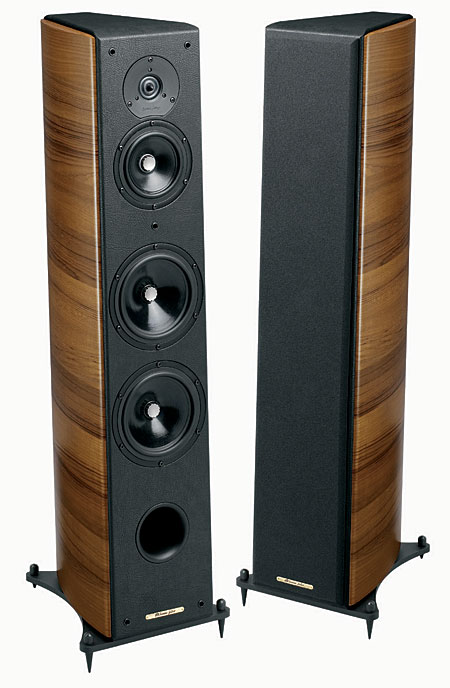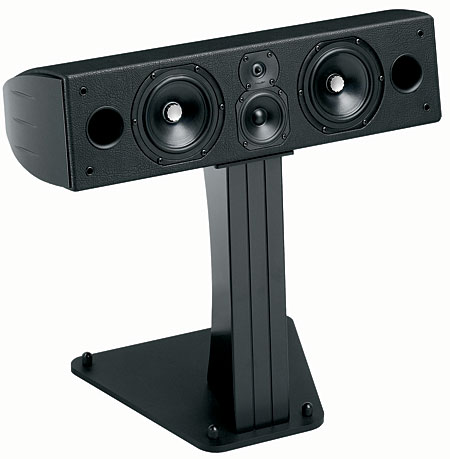The Sonus faber DOMUS Surround Sound System

With the introduction of the new fully shielded DOMUS series, Sonus faber brings the elegant lute shape of its highly regarded (and gorgeous) Homage and Cremona series speakers to a much more affordable price point: a pair of floor-standing, three-way Grand Piano DOMUS costs $4,795. That's roughly a little more than half the price of a pair of Cremonas. The front-ported design features dual 7" woofers, a 6" midrange, and a 1" ring radiator tweeter. Weighing in at approximately 57 pounds, and standing three and a half feet tall and more than a foot deep, the Grand Piano DOMUS represents a substantial upgrade to the HREF="http://ultimateavmag.com/speakersystems/26/index5.html "> Concert Series Grand Piano Home speakers I reviewed for Stereophile Guide to Home Theater back in 2002, yet it costs only 1/3 more.
I chose to review a system consisting of a pair of Grand Piano DOMUS for front L/R, the Center DOMUS ($1,295), a pair of Concertino DOMUS ($1,495/pr.) stand-mounted speakers for the surrounds and a Gravis DOMUS subwoofer ($2,495).
The New Boss vs. The Old Boss
After a tour of the original Sonus faber factory a number of years ago (the company has since built a large new facility next door to the original one, which it still uses), I was privileged to have dinner with founder and chief designer Franco Serblin and his family. Serblin is a man with a sonic aesthetic that's as well developed as his visual one. I found him relaxing in a chaise lounge on his deck, shoeless, dressed in a T-shirt and a pair of shorts. Yet he managed to possess a sense of style that had me thinking I could have shown up in a tuxedo and he'd still have out-styled me.
The sonics of the Concert Series speakers were quite accomplished, as one would expect from Sonus faber. But probably because of the costs involved, the Concert series lacked the graceful lute shaped cabinetry Sonus developed for the homage series loudspeakers. Sonus claims that the lute shape is about more than just looks: the cabinet's non-parallel surfaces prevent internal standing waves while providing better air control within the vented design. The curvaceous side "cheeks" are finished in either black lacquer or a satiny Teak wood.
Speaking of cosmetics, if your home theater plans include burying speakers in walls, behind scrims, and otherwise out of sight, all the work and expense that went into the DOMUS line's looks would be wasted, and you would probably be better off looking at other speakers, unless you fell completely in love with the DOMUS line's sound, and price ($10,080 for the review system, not including stands) was not an issue.

Still, as attractive as the DOMUS series cabinets are, they can't compare to the woodworking of Sonus' Guarnari and Amati speakers. The cabinets in those speakers are a combination of solid cured maple and a complex system of laminated components stained with a special formulation that's hand-applied in a delicate procedure only a few artisans are capable of performing. Finally, a high-gloss lacquer is applied, giving the finish a luxurious look and feel that has to seen and felt to be truly appreciated. But then the price for a pair of Amati anniversario is around $25,000!
Like the Concert series, the new DOMUS range features ingeniously decoupled side panels that, in conjunction with the leather wrap, are said to control cabinet resonances based upon Mr. Serblin's studies of how the great violinmakers crafted their instruments.
The DOMUS series drivers have been heavily upgraded from those used in the Concert series and are based on the proprietary vented phase plug designs developed for the Stradivari homage. A variant of the very popular Vifa ring radiator used in previous Concert series speakers has been retained throughout much of the DOMUS line.
The DOMUS Grand Pianos
The big, three-way DOMUS Grand Pianos do cost more than the Concert series Grand Pianos they replace, but they are so much more capable in every way. Where the original was a two-way with a passive radiator, the new design is a ported three-way that plays louder without strain, is far more dynamic at both ends of the scale, and extends far lower in the bass. Sonus suggests running them full range in a 5.1-channel system and that's what I did. I also found that the familiar ring radiator tweeter here provided far smoother high frequency response than the slightly excessive top end of the older Grand Piano. In addition, while the original Grand Piano's silk dome tweeter featured a rather steep suck-out in the vertical axis, making listening height and/or speaker front baffle rake angle critical, the ring radiator's smoother off-axis vertical response makes the overall high frequency balance of the DOMUS far less dependent upon the height of the listening position and/or the speaker's rake angle.
So, both cosmetically and sonically the new DOMUS Grand Piano represents a big step up from the original. The tonal balance has more in common with the more expensive Sonus faber speakers than with the original Grand Piano. The DOMUS Grand Piano features a smooth, extended top end, a slightly suppressed but pleasing upper midrange, and a very sweet, smooth, well-balanced midrange, which is a Sonus specialty (I'll be curious to see if the measurements correlate with what I heard).
The original Grand Piano was good down to around 40Hz, below which response dropped off admirably, free of any attempted "bumps" suggesting more bottom end than there really was. The three-way DOMUS Grand Piano clearly extends lower, and is more effortless in doing so. More importantly, top to bottom driver integration is exceedingly well done, with no seams sticking out. In this regard the DOMUS Grand Piano is a major improvement over the Concert series Grand Pianos.
Despite being placed between a large RPTV, the DOMUS Grand Pianos managed to disappear effectively, producing an expansive, transparent soundstage that was convincingly tall and wide. Even if the measured upper mids prove to be slightly recessed, the speaker's smooth, somewhat forgiving, yet admirably detailed presentation makes long term listening exceedingly pleasurable. The balance makes edgy soundtracks tolerable, while the really good ones still manage to shine.
My biggest gripe with the DOMUS Grand Pianos is the odd vertical placement of their binding posts. There's enough real estate on the lute-shaped cabinet's rear panel for the posts to be placed horizontally, but for some reason the designer chose vertical placement, which makes hiding the cables difficult.
Center DOMUS
The new three-way Center DOMUS features a 3/4" ring radiator tweeter/3" coated paper midrange combo that's vertically stacked and flanked by dual 6" coated paper cone woofers. Sonus managed to fit it all into a sleek, leather and wood-clad box that's only five inches tall, two feet wide, and a foot deep. This is a substantial upgrade from the first Concert series center channel speaker, which was a two-way design that flipped a D'Appolito configuration (two woofers flanking a tweeter) on its side. As we all know, this is not a good idea, as the "lobing" interference between the drivers produces off-axis frequency response suck-outs that kill dialog intelligibility.






























































